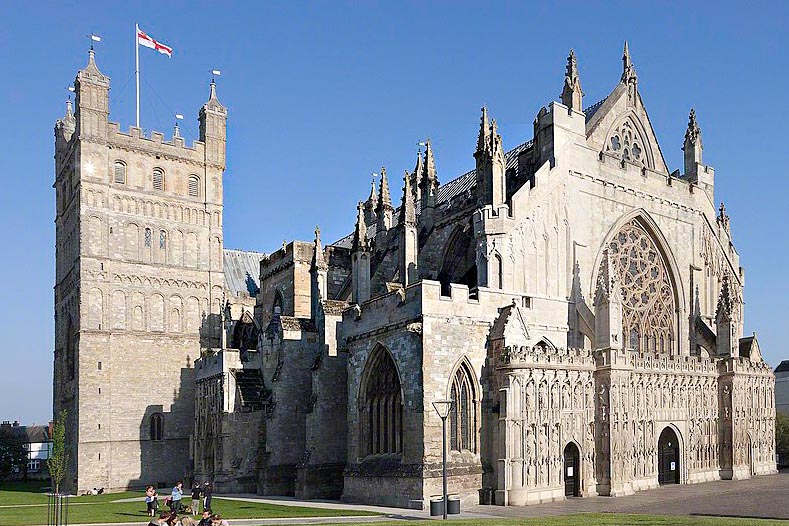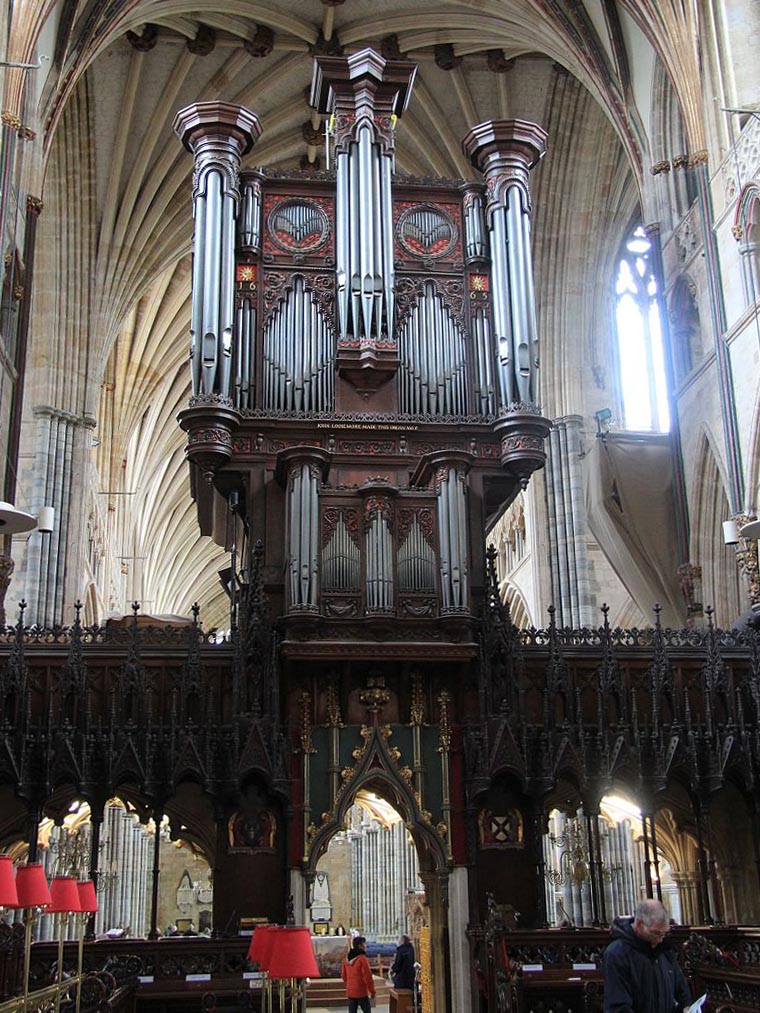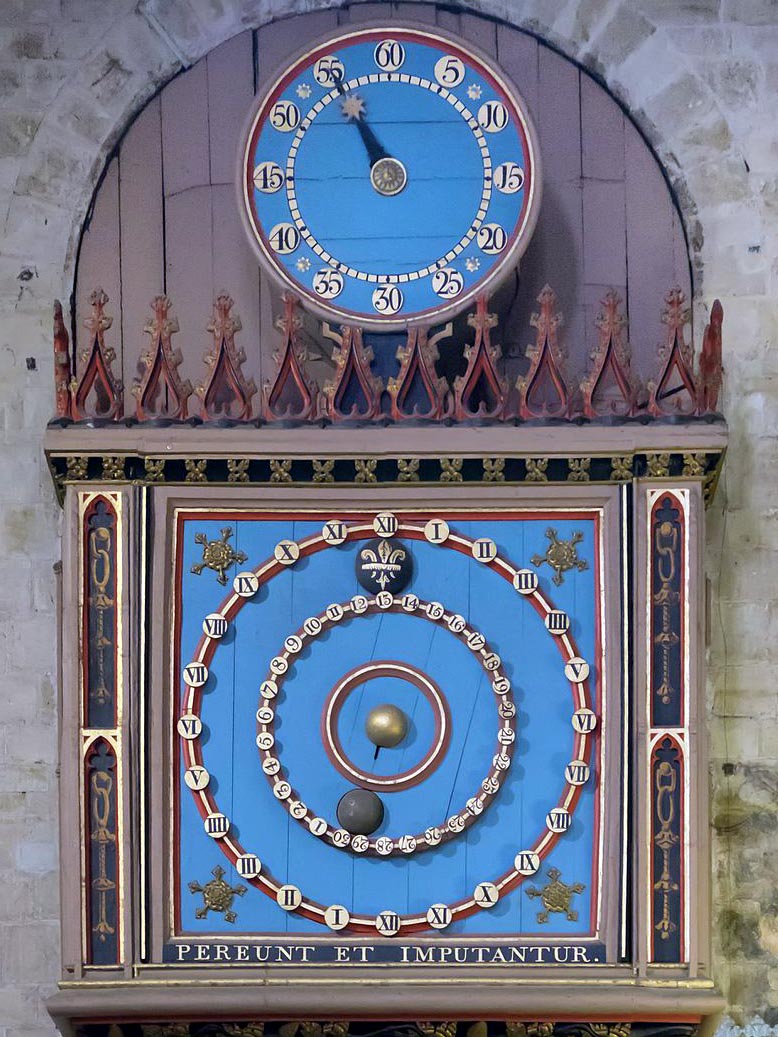| |
 |
 |
 |
| Comment on this report, or find other reports. |
 |
| Our Mystery Worshippers are volunteers who warm church pews for us around the world. If you'd like to become a Mystery Worshipper, start here. |
 |
| Find out how to reproduce this report in your church magazine or website. |
|
|
| 3274: Exeter Cathedral, England |
 |

Photo:
© WyrdLight.com and used under license
|
 |
Mystery Worshipper: Werburga of Chester.
The church: Cathedral Church of St Peter at Exeter, Exeter, England.
Denomination: Church of England, Diocese of Exeter.
The building: The cathedral was founded in 1050 and the first building was in the Norman style. The present cathedral largely dates from major rebuilding in the 14th century, though much of the Norman original was retained. It was constructed entirely of local stone. It has several notable features, including a magnificent vaulted ceiling with brightly painted bosses, an early set of misericords, and an astronomical clock. Also, on the north side of the nave, there is a high gallery decorated with sculptured angels playing a range of 14th century musical instruments.
Like most English cathedrals, Exeter suffered during the dissolution of the monasteries by King Henry VIII and also during the English Civil War, but following the restoration of the monarchy in 1660 a new pipe organ was built on top of the stone screen that divides the nave from the choir. Itís still there, having been substantially rebuilt over the years but continuing to support daily worship.
During the 19th century some refurbishment was carried out, and the nave has recently been reordered with a beautiful modern nave altar and lectern, apparently designed to match the stone tracery of the large west window.
The church: The cathedral community seems to be fully involved with the surrounding city. It supports the local food bank and offers a range of lectures both around a theme (e.g. for Lent) and occasional events exploring church architecture. At least one member of the cathedral clergy is a professor at Exeter University and guest lecturers are also drawn from university faculty. The cathedral welcomes theatre groups and is a major concert venue for the city. The annual Exeter Christmas market is held around the cathedral during Advent. When a nearby historic hotel burned down, the cathedral community offered support to the fire brigades attempting to control the fire, and hosted a service afterwards to give thanks because no lives were lost.
The neighbourhood: The cathedral sits in the middle of an area of green space further surrounded by various secular buildings of assorted ages. Behind those is the bustling modern city centre. Exeter is the county town of Devon and sits alongside the River Exe. It was badly damaged through bombing during the Second World War and much of the city centre had to be rebuilt afterwards. It is the home of a modern university (founded 1851) and is a centre for tourism, which is now one of its major industries. Its quay was first used as a port in prehistoric times to unload the ships of overseas traders and is now one of the most attractive areas of the city, popular with locals and tourists because of its history, riverside walks, and restaurants.
The cast: The Rt Revd Martin Shaw, retired Scottish Episcopal Bishop of Argyll and The Isles and acting precentor, led the service. The Ven. David Gunn-Johnson, retired Archdeacon of Barnstaple and cathedral chaplain, preached. The cathedral choir was directed by Timothy Noon.
The date & time: Sunday, 27 January 2018, 4.00pm.
Comment:
We have received a comment on this report.
What was the name of the service?
Evensong.
How full was the building?
About 80-90 people. The area around the choir was full and some people were sitting on seats closer to the high altar.
Did anyone welcome you personally?
Yes. The choir were still rehearsing when I arrived, so the congregation were not allowed into the worship area. Three men neatly dressed in suits and wearing pendant badges of office on red ribbons were clearly stewards. One of them asked me if I was attending evensong and handed over a service booklet and weekly notices.
Was your pew comfortable?
Yes. A mediaeval carved seat, well padded with a cushion.
How would you describe the pre-service
atmosphere?
Reverent. Not much chatter.
What were the exact opening words of the
service?
"O Lord, open thou our lips," sung by one of the choir basses.
What books did the congregation use during the
service?
A special printed booklet for the words of the service, but copied from the Book of Common Prayer, was available in the pews, which was useful if worshippers wanted to follow the words of the psalm. Plus the New English Hymnal.
What musical instruments were played?
Organ.

Photo:
© Karl Gruber and used under license
Did anything distract you?
I was mystified as to why a retired bishop is the acting precentor. He did not actually sing the responses (as precentors usually do). However, the music was so good that I was able to subdue my loss of concentration very quickly.
Was the worship stiff-upper-lip, happy clappy, or
what?
Book of Common Prayer evensong is formal but not to the point of stiff-upper-lip.
Exactly how long was the sermon?
10 minutes.
On a scale of 1-10, how good was the preacher?
9 – The chaplain preached an excellent homily clearly and with quiet humour.
In a nutshell, what was the sermon
about?
He drew on both Bible lessons. Recalling the impact that the story of Samuel (1 Samuel 3:1-20: the Lord calls Samuel) had on him as a boy, he reminded us of how hard it must have been for Samuelís mother to give him back to God as she had promised. Samuel went on to be the first prophet in Israel since Moses, because he responded to Godís call. We also are called by God, not once, but over and over again, to do his work wherever he calls us to do it. Moreover, as Paul reminds us, we are also called to work for the common good of all.
Which part of the service was like being in
heaven?
The anthem. Ascribe unto the Lord by Samuel Sebastian Wesley is always an exciting piece, and the opening fortissimo from the tenors and basses gave full effect to its potential. Only eight voices were singing at that point, but they really raised the rafters with a warm, rich sound.

Photo:
© Edward Swift and used under license
And which part was like being in... er... the other place?
The reading of the second lesson (1 Corinthians 14:12-20: speak with the mind, not in tongues) seemed unwontedly over-dramatic. However, the declamatory style did draw attention to St Paulís rather smug self-congratulation, so perhaps it was not entirely inappropriate.
What happened when you hung around after the service looking lost?
The chaplain greeted the general exodus with handshakes and well wishes.
How would you describe the after-service
coffee?
Wrong time of day for coffee. There was a tea laid on for the local group of the Friends of Cathedral Music, who also attended evensong, but that was not on general offer.
How would you feel about making this church your regular (where 10 = ecstatic, 0 = terminal)?
8 – Hard to decide on a single visit. I would want to meet more of the regular clergy before deciding. But I would be happy to hear the chaplain preach again.
Did the service make you feel glad to be a
Christian?
Yes.

Photo:
© DeFacto and used under license
What one thing will you remember about all this in seven days' time?
The Wesley anthem. |
|
|
 |
 |
 |
| We rely on voluntary donations to stay online. If you're a regular visitor to Ship of Fools, please consider supporting us. |
 |
 |
 |
| The Mystery Pilgrim |
 |
| One of our most seasoned reporters makes the Camino pilgrimage to Santiago de Compostela in Spain. Read here. |
 |
 |
 |
| London churches |
 |
| Read reports from 70 London churches, visited by a small army of Mystery Worshippers on one single Sunday. Read here. |
| |
|
|
|
|


